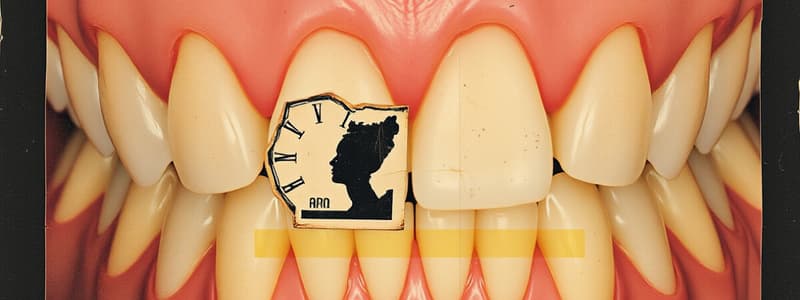Podcast
Questions and Answers
What is associated with RT 1 in the Cairo Classification System?
What is associated with RT 1 in the Cairo Classification System?
- Infrabony defects
- Loss of interproximal attachment
- Traumatic toothbrushing (correct)
- Gingival recession (correct)
Which type of recession does RT 2 in the Cairo Classification System describe?
Which type of recession does RT 2 in the Cairo Classification System describe?
- Gingival recession with no attachment loss
- Gingival recession with interproximal attachment loss (correct)
- Gingival recession with buccal loss
- Gingival recession with infrabony defects (correct)
How does RT 3 differ from RT 2 in the Cairo Classification System?
How does RT 3 differ from RT 2 in the Cairo Classification System?
- RT 3 includes infrabony defects (correct)
- RT 3 is the same as RT 2 but has greater interproximal attachment loss (correct)
- RT 3 has no gingival recession
- RT 3 has no attachment loss
What does the Cairo Classification System for recession of the gingival margin base its classifications on?
What does the Cairo Classification System for recession of the gingival margin base its classifications on?
What characterizes Class IV of the Miller Classification System?
What characterizes Class IV of the Miller Classification System?
How does Class III differ from Class IV in the Miller Classification System?
How does Class III differ from Class IV in the Miller Classification System?
Class II of the Miller Classification System indicates loss of bone or soft tissue in the interdental area.
Class II of the Miller Classification System indicates loss of bone or soft tissue in the interdental area.
Class I of the Miller Classification System is characterized by marginal recession that extends to MGJ.
Class I of the Miller Classification System is characterized by marginal recession that extends to MGJ.
Flashcards are hidden until you start studying
Study Notes
Cairo Classification System Recession Types
- RT 1: Gingival recession without interproximal attachment loss; often linked to traumatic toothbrushing.
- RT 2: Gingival recession with interproximal attachment loss; commonly associated with periodontitis and horizontal bone loss.
- RT 3: Similar to RT 2, but characterized by greater interproximal attachment loss compared to buccal loss and includes infrabony defects.
Cairo Classification System Overview
- Utilizes clinical attachment level (CAL) measurements at both buccal and interproximal sites.
- Employs objective criteria to classify the severity and extent of soft tissue recession.
- Applicable in clinical practice for effective assessment.
Miller Classification System for Recession of Gingival Margin
- Class I: Marginal recession not extending to the mucogingival junction (MGJ) with no interproximal bone or soft tissue loss; roots fully covered.
- Class II: Marginal recession extending beyond MGJ, but with no interproximal bone or soft tissue loss; roots still completely covered.
- Class III: Marginal recession extending beyond MGJ with bone and soft tissue loss in the interdental space; may prevent coverage of certain roots due to tooth malpositioning.
- Class IV: Marginal recession significantly extending beyond MGJ with marked bone and soft tissue loss in interdental areas; often associated with malpositioning of teeth that hinders coverage of multiple roots.
Studying That Suits You
Use AI to generate personalized quizzes and flashcards to suit your learning preferences.




